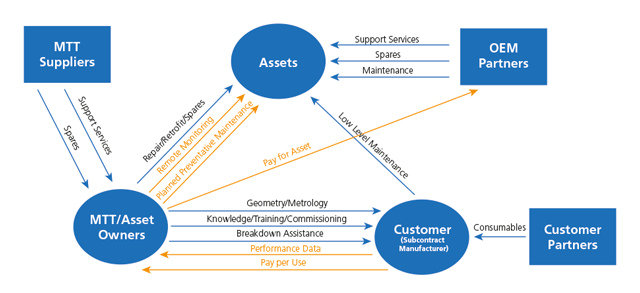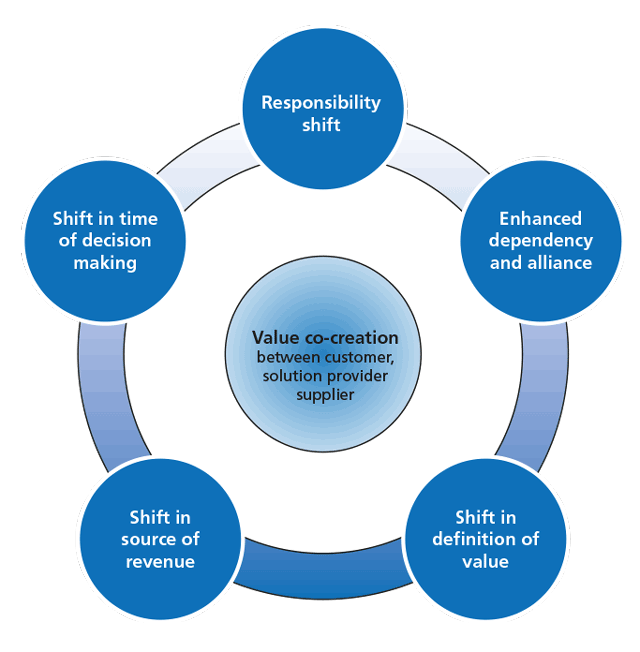 ABSTRACT
ABSTRACT
Through-life engineering services (TES) are a set of capabilities, techniques, business thinking and network behaviour that, when applied to major assets, optimise their value and cost (for example keeping assets working better, for longer at lower cost) (PAS 280)[1].
Along these lines, major assets refer to complex engineered products, systems or systems-of-systems with an overall life measured in decades and a need for substantial investment through life. In the process of achieving optimised value and cost, there are many challenges in TES solutions, ranging from commercial (for example business model, value proposition), engineering (degradation, repair mechanisms), and life cycle planning (develop, prepare, utilise, retire) type aspects. This paper focuses on evaluating what are the major challenges that need to be addressed so that through-life thinking can be adopted in the machine tool sector.
Offering integrated products and services has now turned into a conscious and explicit strategy for manufacturers. The provision of product-centric services is becoming a main differentiating factor, which has become known as the servitisation of manufacturing. This paper explores through literature review and industrial survey the current trends and challenges in servitisation experienced within the machine tool sector. Through this study an insight has been provided into what are the requirements to servitise machine tools, and how can equipment and machine tool manufacturers evaluate a servitised delivery system.
Some of the key results from the study indicate that this type of competitive strategy brings with it significant technical, cultural, and corporate challenges for traditional MTS. It has been observed that companies which decide on a product-centric service strategy must transform their organisational structures and processes in order to become successful.
Introduction
Product manufacturing businesses are increasingly focusing on value-creation chains by developing extended service offerings throughout the life of the product. Such offerings are promoting newer business models, where the product itself is no longer sold but its service or performance is sold. Several contracts within product-service systems (PSS) influence such practices, and the process of advancing from limited services to more advanced offereings is termed as ‘servitisation’ [2]. In other words, the concept of servitisation stems from product-service systems and the essence is to move towards adding value to products.
Several successful applications of PSS and servitisation in airlines, railways, infrastructure, heavy equipment, car rental, and the white goods sector can be seen in the literature [3,4]. These range from providing very basic services such as installation, a maintenance plan, take-back and recycling, to the most advanced services that emphasise the value derived from the product more than the product itself – for example, Xerox international’s “pay per copy” model, where the customer only pays for the printed copies rather than the printer itself.
Similarly more complex examples of servitisation include “power by the hour” by Rolls-Royce, which provides a Total Care solution package whereby airline operators buy the engine capabilities rather than the engines [5]. The UK Ministry of Defence has developed the Support Options Matrix, a framework that supports the integration of services from their suppliers by defining and providing the rationale behind each type of contracting option [6].
PSS is widely applied in high value product manufacturing organisations such as Rolls-Royce, Alstom, Caterpillar and so on. However, overall PSS has not widely attracted interest in the machine tool sector for equipment and machine tool manufacturers, which are the service providers [7].

However, there are a number of challenges that are experienced that hinder the succesful adoption of PSS. Accordingly, this article aims to highlight some of the challenges experienced by the machine tool sector in transforming its organisations.
Emerging challenges influencing the machine tool sector
The emergent challenges are driven by a range of uncertainties experienced, which arise with the agreement of PSS in the MTS. The criteria for emerging challenges include:
- Whether new service features are offered
- Whether new aspects associated with the relationships across the supply network are experienced
- Whether new processes and capabilities are utilised to fulfil the service requirements.
The emergent uncertainties are associated with both the customers’ and the manufacturers’ activities in the process of co-creation of value. The list includes [8]:
Equipment availability:
Becomes a key element of the contract as a performance criterion. In the traditional contract this aspect had not been defined as a requirement by the customer. The uncertainty is associated with the level of equipment availability achieved, which is dynamic.
Payment based on performance:
The uncertainty is associated with achieving the performance requirements, particularly with respect to equipment availability. In alignment, an associated uncertainty is the way the budget varies over time.
Human performance:
The focus of this uncertainty is human performance during the service delivery process. A major element of this uncertainty is the skill level of maintainers, which requires continuous update; also, skills obsolescence is a major challenge due to the long time frame.
End user equipment usage:
The customer influences the equipment availability level through its equipment usage preferences. This uncertainty is associated with the utilisation rate and equipment misuse. The manufacturer needs to take into account this uncertainty in order to deliver availability.
Change in evolving constraints for support:
Due to the nature of the customers’ instant support requirements, the OEM needs to be able to organisationally reconstruct itself. It is an emergent uncertainty due to the nature of the evolving constraints that influence the OEM in meeting the commitment.
Intangible expectations:
The concept of co-creation of value means that the customer and the manufacturer build close relationships, and in essence intangible expectations such as satisfactory communication and on-time delivery become essential parts of the system.
Change in capability requirements:
The uncertainty arises from the additional responsibilities that the OEM takes to meet the changes in the capability requirements. It is also necessary to recognise the boundaries of a contract, because significant changes in capability requirements can be considered through renegotiation.
Lack of information and knowledge sharing:
Integration between the activities of the customer and the manufacturer is required in order to reach the targeted level of co-creation of value. In order to reach this, information and knowledge concerning the service requirements and delivery need to be shared. Uncertainty is associated with this sharing and it is an emergent uncertainty, due to the dependency between the customer and the manufacturer.
Supplier dependence:
Across the supply chain, with the increase in the transfer of responsibility from the customer to the OEM and to suppliers, there is an increase in dependency among suppliers. The uncertainty is associated with the performance of each supplier and how this affects the outcome of the system.
Training for availability:
The manufacturer offers specific training services to maintain the availability level. Such an approach has not been applied in the traditional context and emergent uncertainties in the process of service delivery have emerged with regard to achieving performance goals for training.
The transformation of the business model to a whole life perspective causes changes in for the supply network in:
- Responsibility: The transfer of service activities along the supply network
- Time: The decisions made concerning various aspects related to service delivery
- Information: The source and flow of information changes among stakeholders
- Stakeholders’ dependency and alliance: The collaboration across the supply network (co-creation of value across supply network)
- Capability or knowledge: Requirements in terms of knowhow to fulfil the needs of the new context in service delivery
- Importance of value: Change in what the customer considers as added value
- Source of revenue: The change in the architecture of generating revenues.
Figure 2 aims to illustrate these causes of change in uncertainties. Co-creation of value forms the central focus of the system among the stakeholders.

Understanding the challenges across the supply network
This section aims to explain the implications of the uncertainties considered across the supply network. An emergent uncertainty such as “end user equipment usage” is considered to originate at the customer. Additionally, the responsibility of managing a transformed uncertainty such as “obsolescence” is passed from the customer to the manufacturer/service provider, which is largely the case for the complete list of uncertainties. Furthermore, there are a number of uncertainties which are experienced collaboratively. The uncertainty of “lack of information and knowledge” poses an example that the customer, manufacturer and supplier collaboratively face. An uncertainty that both customer and manufacturer face is “payment based on performance”. Below, further information about some of the key uncertainties is provided through examples.
Equipment availability becomes a new uncertainty for the OEM becuase such a demand had not been part of the traditional model. This involves transfer of support-related processes to the solution provider. The performance-driven attitude is a new perspective, which makes the enabling aspects such as service processes less important to the customer because the responsibility of managing processes is transferred across the supply chain at varying degrees. The OEM focuses on understanding these uncertainties at the bidding phase, which is earlier than the traditional context and poses a high degree of uncertainty because of the lack of information about life cycle expectations.
Along these lines, the OEM enhances its communication with the customer in order to gather an in-depth understanding of the equipment usage and the evolution of the equipment conditions. Furthermore, due to the performance goal, integration across the supply chain (for example, storing parts and sharing information) is required. The OEM needs additional capability to track equipment health and to share information with suppliers.
Failure rate for hardware will become less and less the responsibility of the customer. When preparing the budget for a new project the customer needs to consider the failure rate, in order to communicate the expected cost level. The customer becomes an important source of information for the supply network, and has to manage the flow of information in order to achieve the performance required. For the OEM, failure rate stops being a source of revenue, because the customer pays for the outcome of using the equipment or having the equipment readily available for use when required.
As the responsibility moves to the solution provider, it becomes essential to have suitable processes to actively fulfil demand. These processes involve planning for failure and delegation across the supply chain to manage impact. The suppliers become more integrated to the supply chain as they are integrated to achieving customer requirements.
Conclusions
There is an exciting shift towards through-life solutions in the machine tool sector. This is promoting the need to evaluate technology, skills and process-related maturity. This is also creating a need to explore alternative contracting approaches that will offer win-win scenarios across the supply network enabled by co-creation of value. Digital technologies that can provide up-to-date information and analysis about the health of the machine tools will become increasingly used and critical for the industry.
Acknowledgements
This research is supported by an Innovate UK funded project – Metrology and Digital Manufacturing for Servitisation of Manufacturing Machines (grant number: 102787). The authors acknowledge colleagues from Machine Tool Technologies, Newburgh Precision, Airbus, Tritech Group, ADA Machining Services, AMRC, and University of Huddersfield who provided insight and expertise that led to the development of the ideas and concepts presented in this paper.
References
[1] PAS 280:2018 Through-life engineering services: Adding business value through a common framework – Guide, BSI Standards Ltd 2018, ISBN 978 0 580 52422 6
[2] Vandermerwe S, Rada J. Servitization of business: adding value by adding services. European management journal. 1988 Dec 1;6(4):314-24.
[3] Hirschl B, Konrad W, Scholl G. New concepts in product use for sustainable consumption. Journal of cleaner production. 2003 Dec 31;11(8):873-81.
[4] Ahamed Z, Inohara T, Kamoshida A. The servitization of manufacturing: An empirical case study of IBM corporation. International Journal of Business Administration. 2013 Mar 14;4(2):18.
[5] Neely A. The servitization of manufacturing: an analysis of global trends. In14th European Operations Management Association Conference 2007 Jun 17 (pp. 1-10). Turkey Ankara.
[6] Goedkoop, M.J., van Halen, C.J.G., te Riele, H.R.M., Rommens, P.J.M., (1999) Product Service Systems, Ecological and Economic Basics. Report for Dutch Ministries of Environment (VROM) and Economic Affairs (EZ).
[7] Sachidananda, M., Erkoyuncu, J. A., Roy, R., Mcvey, S. and Drever, P. (2017) Opportunities and Barriers for Servitisation in Machine Tools Sector 39TH Matador Conference, University of Manchester.
[8] Erkoyuncu, J.A., Durugbo, C. and Roy, R. (2013) Identifying uncertainties for industrial service delivery: a systems approach, International Journal of Pro-duction Research, 51(21), pp. 6295-6315. Doi: 10.1080/00207543.2013.794316 (JCR 2017 IF 2,623). Cited by: 28.

